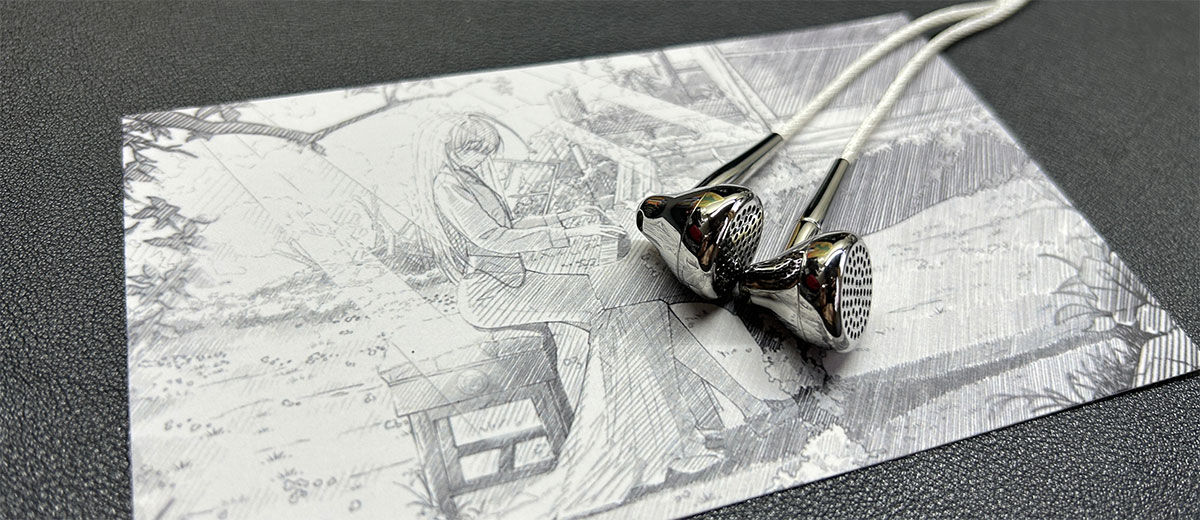In this feature, Meldrick reviews the MOONDROP Pavane, the company’s latest flagship 13.5mm dynamic driver stainless-steel flathead earbuds. They are currently priced at $379.99.
Disclaimer: This sample was sent to me in exchange for my honest opinion. Headfonics is an independent website with no affiliate links or status. I thank MOONDROP and Shenzhen Audio for their support.
Click here to read more about MOONDROP products we have previously reviewed on Headfonics.
This article follows our current scoring guidelines, which you can read here in more detail.
It’s safe to say that within the Chi-Fi space, earbuds don’t quite get the same attention as IEMs and headphones, but this hasn’t stopped MOONDROP from releasing their latest flagship earbuds, the Pavane.
Coming in at $379, the Pavane is meant to commemorate MOONDROP’s 10th anniversary and its original goal of creating a satisfying flat-head earbud.
To see if the Pavane has what it takes to keep up with its peers in this niche yet fierce segment, and how it compares with the likes of the FiiO FF3, you can read my full review below.
Features
The Pavane builds and refines upon MOONDROP’s previous flagship IEMs, such as the Chaconne and Liebesleid, swapping the heavier brass material found on the Liebesleid for a lighter stainless steel.
This stainless steel is meticulously turned, milled, and polished, giving the Pavane a durable and almost glass-like finish
At the heart of the Pavane is a newly developed 13.5mm high-performance driver built with an external N55 magnet array.
According to MOONDROP, these advancements give the Pavane improved dynamics and transients, while remaining compact enough to prevent a compromised treble response.
The driver makes use of a new DLC diaphragm designed through stringent finite element analysis on its acoustic characteristics to deliver superior performance across the frequency range while maintaining good detail and resolution.
Design
What immediately stands out is the Pavane’s striking mirror-like finish. Built from polished stainless steel, it builds on a visual motif shared not only by the brand’s earlier flagship earbuds but also by their IEMs, such as the Blessing 3.
Surprisingly, I found that the Pavane was much more resistant to scratches and fingerprints than other IEMs I’ve tried with a similar mirror-like finish. I remained careful handling the Pavane throughout my testing, but this made me more confident to take it around and use it in public.
Don’t get me wrong, the Pavane is still quite a fingerprint magnet, but I found myself having to wipe it down much less than the Blessing 3.
Both the earbud shells and stems are constructed from the same polished stainless steel, giving the pavane a premium feeling of density when held in hand, while also being light enough for all-day use when in the ear.
It is also worth noting that the Pavane is completely void of any Left or Right indicators on the earbuds or the cable.
This may have been done to preserve the sleek classical aesthetic, but this also made it impossible to determine which earbud goes where without testing them first with test tracks that isolate the left and right channels.
The Pavane has a slight gray tint that is darker than the MOONDROP Blessing 3, but lighter than the Simgot EA500LM. I found that this makes it just subdued enough when they’re placed in your ear, without completely nullifying its remarkable finish.
Machining
The stainless-steel shell is expertly machined, with gentle curves and contours that seamlessly flow into one another. Even the point where the shell connects to the stem is constructed with such tight tolerances that I can barely feel their seam while I run my finger through it.
However, I did notice that the machining on the vents placed at the top and bottom of the shell was quite deep and pronounced.
During my testing, I noticed a rough, grainy sensation whenever I’d run my finger across the vent, however, this did not cause any pain.
Comfort & Isolation
For those more used to IEMs, the way earbuds lie atop the ear canal may take some getting used to, but over time, they do feel more comfortable than most IEMs.
The shells of the Pavane are larger than other earbuds I’ve tried, such as the Fiio FF3 and Venture Electronics ZEN LL, causing them to sit further out on my ear. This gives them a slightly less secure fit compared to the aforementioned earbuds.
The comfort and in-ear stability of the Pavane rely heavily on the use of the included donut-style foam. This is a more secure fit, especially during on-the-go usage. Throughout my mixed desk and on-the-go usage, the Pavane never fell out of my ear and always remained securely in place.
The thin, cylindrical stems of the Pavane never caused any discomfort; they never pressed against my ear or caused any weight-related discomfort.
The Pavane is a decently comfortable set of earbuds that stays secure in-ear when the foam pad is used. However, those used to MX500-style earbuds or those by other Chi-Fi brands may need to get used to the Pavane’s larger shell.
Stock Cable
MOONDROP opted for a fixed, non-detachable cable composed of a 2-wire high-purity single-crystal copper weave with silver-plated Litz configuration to reduce signal interference and preserve audio detail.
According to MOONDROP, a fixed cable was chosen to preserve the elegant aesthetic of the overall earbuds.
While I admit that the white-silver color scheme fits the earbuds well, I would have preferred the option to replace the cable just in case it were to break in the future, or even just to better suit my listening setup.
MOONDROP compensates for the lack of swappable connectors by including a modular plug system, allowing users to easily switch between 3.5mm and 4.4mm terminations to suit different sources.
The modular plugs feel secure when installed and follow a similar screw-lock setup as the DUNU Lyre Mini cable. The terminations are aided by alignment indicators to make the attachment process hassle-free.
During daily use, I found the cable to be soft and pliable, with minimal microphonics even when walking outdoors.
The rubber sheath resists tangling and holds no significant memory, which made handling the Pavane quick and frustration-free whenever I pulled it out for casual listening or more focused testing.
Packaging & Accessories
The MOONDROP Pavane comes in a tasteful box featuring a pencil-style anime illustration, consistent with MOONDROP’s design aesthetic.
Inside the box, the Pavane and its accessories are neatly arranged. The 3.5mm termination is pre-attached to the Pavane’s cable, however, it comes with a modular 4.4mm termination plug as well.
The Pavane also comes with 2 pairs of black donut-style foams that give the earbuds a more secure fit. I would have appreciated the inclusion of more than 2 pairs of foam tips, since these tend to wear out quickly based on my experience.
Additionally, the Pavane also includes a compact round carrying case made of stitched faux leather with the MOONDROP branding embossed on the lid. I found that the case was too large to fit in a pocket, but it was compact enough to fit in backpacks or sling bags.
Lastly, the Pavane includes a postcard with the Pavane anime mascot up front, a user manual, a quality certificate, and a service card. While the accessory set is not extensive, it is thoughtfully curated and consistent with the Pavane’s high-end presentation.
Sound Impressions
Throughout my testing, I paired the Pavane with the ddHiFi TC35pro E2, iFi audio GO Link Max, 7Hz Artemis39, FiiO K11, FiiO K11 R2R, and Shanling EH2.
Bass
The MOONDROP Pavane has a very lean and reserved low-end. While bass notes are present, they lack physicality and weight, even when powered by warmer desktop sources.
Sub-bass is minimal, with little rumble or texture. Kick drums and basslines are audible but lack tactility and note definition, often sounding like generic thumps rather than percussive instruments with body and nuance.
In rock and hip-hop tracks, low-end percussive instruments sound like they’re being played through a low-quality drum machine hooked up to a speaker setup. They are not bloated at all, but they sound artificial due to their lack of harmonics and tactility.
Mid-bass is slightly more apparent, but it still lacks warmth or punch. Bass guitars and synths are heard but not felt, with limited depth or layering. When listening to funk and disco tracks, this lean mid-bass presentation sucks away the groove that these tracks are known for.
Even when paired with R2R-based DAC/AMPs like the FiiO K11 or Shanling EH2, the bass remains noticeably uninspiring, especially for genres that rely on low-end impact, such as hip-hop or rock.
While the bass presentation is underwhelming, this leaner bass presentation removes all bass bloat and contributes to the overall neutral-bright leaning sound signature of the Pavane.
Mids
The midrange of the Pavane is clean, articulate, and forward-leaning, with a clear focus on vocal intelligibility and upper-mid clarity.
Male and female vocals alike are presented with consistent emphasis, often sitting slightly above the instrumentation rather than blending into the mix.
However, the mids do lean on the thinner side, particularly in the lower midrange, which can cause some instruments like baritone saxophones, pianos, or acoustic guitars to lack body and warmth.
This is especially noticeable in genres like folk or jazz, where midrange weight is critical to conveying a natural timbre.
That said, the upper mids are where the Pavane truly shines. Electric guitars in alternative rock tracks have bite and good harmonics, violins in orchestral arrangements display excellent bow-string texture, and snare drums in classic rock tracks snap with good resolution.
Treble
The Pavane’s treble is detailed, clean, and airy without crossing into sharpness. Treble elements like cymbals and hi-hats are rendered with excellent imaging and tonal balance.
Each cymbal strike in jazz recordings sounds like it comes from a dedicated driver, never smearing together or blending indistinctly. There’s a sense of separation that I haven’t heard in the other earbuds I’ve tried.
Interestingly, while the Pavane presents as a bright-neutral earbud, this brightness is not due to excessive treble energy.
Even in poorly mastered tracks that induce sharp “s” and “t” sounds or aggressive hi-hats, the Pavane manages to balance the treble energy while having enough restraint to avoid sibilance.
This sense of brightness seems to stem not from a boosted treble shelf but from a lack of low-end masking. Because there’s very little sub-bass energy to crowd the stage, the treble has ample space to breathe, resulting in a clean, airy presentation that enhances micro-detail.
Staging & Dynamics
When paired with a sufficiently powerful source, such as the FiiO K11, the Pavane delivers a headphone-like soundstage. The Pavane blows away the soundstage of any IEMs I’ve tried and is superior to any earbuds I’ve tested thus far.
Its imaging is very precise, with excellent left-right separation and a commendable sense of layering. Instruments are placed with great spatial accuracy, and busy mixes are handled with finesse.
Compared to most earbuds and even many IEMs, the Pavane’s imaging performance stands out, especially in the treble and upper midrange. Elements like chimes, plucks, and high strings feel spatially isolated and cleanly rendered.
Click on page 2 for my recommended pairings and selected comparison.









